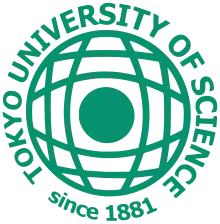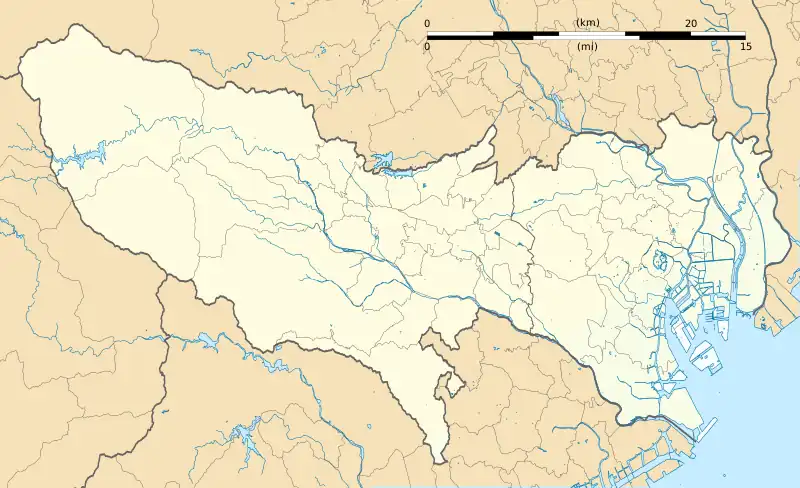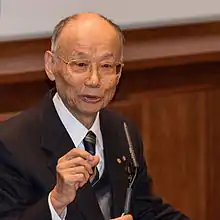 | |
| Motto | An educational foundation for the development of the nation through the advancement of science |
|---|---|
| Type | Private |
| Established | 1881 |
| President | Yoichiro Matsumoto |
| Students | 19,673[1] |
| Undergraduates | 16,518[1] |
| Postgraduates | 2,910[1] |
Other students | 245[1] |
| Location | , , Japan 35°41′58″N 139°44′29″E / 35.699389°N 139.741389°E |
| Campus | Urban: -Kagurazaka main campus -Katsushika campus -Noda campus -Oshamambe campus |
| Affiliations | JUNBA, MANA, K2K experiment |
| Mascot | Bocchan Madonnachan |
| Website | www |
 | |
 Location in Tokyo | |



Tokyo University of Science (東京理科大学, Tōkyō Rika Daigaku), formerly "Science University of Tokyo" or TUS, informally Rikadai (理科大) or simply Ridai (理大) is a private research university located in Shinjuku, Tokyo, Japan.
History
Tokyo University of Science was founded in 1881 as The Tokyo Academy of Physics by 21 graduates of the Department of Physics in the Faculty of Science, University of Tokyo (then the Imperial University). In 1883, it was renamed the Tokyo College of Science, and in 1949, it attained university status and became the Tokyo University of Science.[2] The leading character appearing in Japanese novelist Soseki Natsume's novel Botchan graduated from Tokyo University of Science.[3]
As of 2016, it is the only private university in Japan that has produced a Nobel Prize winner and the only private university in Asia to produce Nobel Prize winners within the natural sciences field.[4]
Academic rankings
Global university rankings
Academic Ranking of World Universities ranked Tokyo University of Science in equal 13th place in Japan.[5]
Graduate school rankings
Eduniversal ranked Tokyo University of Science second in its rankings of "Top business school with significant international influence" in Japan.[6]
Alumni rankings
In Times Higher Education ranking of CEOs of the world's largest enterprises, it is ranked third for Japanese universities.[7]
Campuses
Tokyo University of Science main campus is located in the Kagurazaka district of Shinjuku. The nearest station is Iidabashi Station.
Apart from the main campus in Shinjuku, there are other campuses around the country:
- Kagurazaka (Main) Campus: Shinjuku
- Fujimi school building: Chiyoda-ku, Tokyo
- Katsushika Campus: Katsushika-ku, Tokyo
- Noda Campus: Noda, Chiba
- Oshamambe Campus: Oshamambe, Hokkaido
Facilities
Libraries
Tokyo University of Science has libraries in four different areas: Kagurazaka, Noda, Katsushika and Oshamambe.
- Kagurazaka Library
- Noda Library
- Katsushika Library
- Oshamambe Library
Museum and other facilities


Other libraries on Tokyo University of Science campuses include:
- Science and Technology Museum
- Athletic Facilities
- Seminar House
- Training Center
- Morito Memorial Hall
Undergraduate and graduate schools
Undergraduate schools
- Science Division I
- Engineering
- Pharmaceutical Sciences
- Science and Technology
- Industrial Science and Technology
- Management
- Science Division II
Graduate schools
- Science
- Chemical Sciences and Technology
- Mathematics and Science Education
- Engineering
- Pharmaceutical Sciences
- Science and Technology
- Industrial Science and Technology
- Management
- Biological Sciences
- Innovation Studies
- Global Fire Science and Technology
Professional graduate schools
- Management of Science and Technology (MOT)
- Master of Intellectual Property (MIP)
Special Training Course for Teachers
- Division of Mathematics[8]
Research institutes
- University Research Administration Center[9]
- Planning and Management Division
- Research Strategy Formulation Division
- Research & Industry University Cooperation Supporting Division
- Regional Alliance & Commercialization Promotion Division
- Research Institute for Science and Technology[10]
- Research Centers
- Research Divisions
- Division of Pharmaco-creation Frontier
- Division of Integrated Science of Oshamambe town
- Division of Advanced Communication Researches
- International Research Division of Interfacial Thermo-fluid Dynamics
- Division of Nanocarbon Research
- Division of Bio-organometallics
- Division of Thermoelectrics for Waste Heat Recovery
- Division of Colloid and Interface Science
- Division of Synergetic Supramolecular Coordination Systems in Multiphase
- Division of Advanced Urbanism and Architecture
- Academic Detailing Database Division
- Division of Medical-Science-Engineering Cooperation
- Division of Mathematical Modeling and its Mathematical Analysis
- Water Frontier Science Research Division
- Fusion of Regenerative Medicine with DDS
- Photovoltaic Science and Technology Research Division
- Advanced EC Device Research Division
- Division of Agri-biotechnology
- Division of Things and Systems
- Atmospheric Science Research Division
- Division of Super Distributed Intelligent Systems
- Brain Interdisciplinary Research Division
- Division of Intelligent System Engineering
- Advanced Agricultural Energy Science and Technology Research Division
- Joint Usage / Research Center
- Research Center for Fire Safety Science
- Photocatalysis International Research Center
- Research Institute for Biomedical Sciences[13]
- Research Institute Division Groups
- Division of Immunobiology
- Division of Molecular Biology
- Division of Biosignaling
- Division of Molecular Pathology
- Division of Development and Aging
- Division of Experimental Animal Immunology
- Division of Clinical Research
- Division of Intramural Cooperation
- Division of Extramural Cooperation
- Research Institute Division Groups
- Research Equipment Center[14]
- Center for Data Science[15]
Academic exchange agreements overseas
As of 2016, Tokyo University of Science had academic exchange agreements with 75 overseas universities and research institutions, including those between departments and departments.[16]
Affiliated schools
The university has two affiliated four-year universities: Tokyo University of Science, Yamaguchi, in Sanyo-Onoda, Yamaguchi, and Tokyo University of Science, Suwa, in Chino, Nagano.[2]
Principals, presidents, and chairmen
Principals
- Hisashi Terao, 1883-1896[17]
- Kiyoo Nakamura, 1896–1930[18]
- Kyohei Nakamura, 1930–1934[18]
- Masatoshi Ōkōchi, 1934–1945[19]
- Nakagoro Hirakawa, 1945–1949[19]
- Kotaro Honda, 1949–1951[19]
- Concurrently appointed president of Tokyo University of Science.
Presidents
- Kotaro Honda, 1949–1953[17]
- Masaichi Majima, 1955-1966[17]
- Seishi Kikuchi, 1966-1970[17]
- Masao Kotani, 1970-1982[17]
- Masao Yoshiki, 1982-1990[17]
- Tetsuji Nishikawa, 1990-2001[17]
- Hiroyuki Okamura, 2002-2005[17]
- Shin Takeuchi, 2006-2009[17]
- Akira Fujishima, 2010-2018, discoverer of photocatalyst[20]
- Yoichiro Matsumoto, 2018- [17]
Chairmen
Notable faculty
- Makoto Asashima, Vice President, discoverer of activin[22]
- Michael A. Cusumano, business administration, vice president, Massachusetts Institute of Technology professor[23][24]
- Chiaki Mukai, JAXA astronaut, Vice President[25]
- Teruaki Mukaiyama, chemist, former professor, discoverer of Mukaiyama aldol addition[26]
- Kensō Soai, chemist, professor, discoverer of Soai reaction[27]
- Jaw-Shen Tsai, physicist, professor[28]
- Noriaki Kano, professor emeritus[29]
- Kazunori Kataoka, former professor, Humboldt Prize winner[30]
- Norio Taniguchi, former professor, Proponent of Nanotechnology[31]
Notable alumni

Nobel prize laureates
- Satoshi Ōmura, biochemist, 2015 Nobel Prize in Physiology or Medicine winner[32][33]
Government
- Shigeru Yoshida, Prime Minister, (Attended University 1896 but dropped out)[34]
Business
- Kazuo Motoyama, President of Asahi Soft Drinks, 2013-2015, Chairman of TUS 2015-[35][36]
- Philip M. Condit, CEO of Boeing, 1996-2003[37]
- Toshihiro Suzuki, CEO of Suzuki, 2016-[38]
- Seiichi Sudo, Vice President of Toyota, 2013-2016[39]
- Tatsuya Tanaka, President of Fujitsu, 2015-[40]
- Shigeki Tanaka, President of Clariant Japan, 2016-[41]
- Masahiro Inoue, CEO of Yahoo! Japan, 1996-2012[42]
- Shigeru Nakane, CEO of SAP Japan, 1993-1999[43]
- Shiinoki Shigeru, Vice President of Oracle Japan, 2013-2016[44]
- Zenji Miura, CEO of Ricoh, 2013-[45]
- Fumikathu Tokiwa, Kao Corporation Chairman. 1997-2000[46]
- Shuhei Nakamoto, Honda Racing Corporation Vice President, Repsol Honda representative[47]
- Takanobu Satō, President of Shinchosha. 1996-[48]
Academia
- Jin Akiyama, mathematician, professor[49]
- Isamu Shiina, professor, discoverer of 2-Methyl-6-nitrobenzoic anhydride, Shiina macrolactonization and Shiina esterification[50]
- Yasuhiko Kojima, virologist, discoverer of Interferon[51]
- Tetsuo Asakura, professor, developer of artificial blood vessels using silk[52][53]
- Tashpolat Tiyip, president of Xinjiang University
Architecture
- Kazuo Shinohara, architect, Venice Biennale awarded a special commemorative Golden Lion[54]
- Hideto Horiike, architect, Visiting Professor of the University of California, Los Angeles, Visiting Professor of the Massachusetts Institute of Technology[55]
Media
- Tsuyoshi Muro, actor, (attended university but dropped out)[56]
Others
- Masayoshi Soken, sound editor[57]
- Hirokazu Yasuhara, video game designer[58]
- Shigeru Nakanishi, artist[59]
- Ryu Ota (1930–2009), politician[60]
- Fushigi Yamada (born 1959), voice actress[61]
- Hiroshi Sakurazaka, author[62]
- Akihiro Murayama, mixed martial artist[63]
See also
References
- 1 2 3 4 Number of Graduate Students. Tokyo University of Science. Retrieved March 26, 2017.
- 1 2 "東京理科大学" [Tokyo University of Science]. Dijitaru Daijisen (in Japanese). Tokyo: Shogakukan. 2012. OCLC 56431036. Archived from the original on August 25, 2007. Retrieved 2012-11-02.
- ↑ History Tokyo University of Science. Retrieved March 9, 2017.
- ↑ Nobel Prize Facts Nobelprize.org
- ↑ Institute of Higher Education, Shanghai Jiao Tong
- ↑ "University and business school ranking in Japan". Retrieved 23 March 2016.
- ↑ Elmes, John (January 2017). "Hothouse powers: The Times Higher Education Alma Mater Index 2017". Times Higher Education. Retrieved 23 March 2016.
- ↑ Special Training Course for Teachers. Tokyo University of Science. Retrieved March 26, 2017.
- ↑ University Research Administration Center. Tokyo University of Science. Retrieved March 25, 2017.
- ↑ Research Institute for Science and Technology. Tokyo University of Science. Retrieved March 25, 2017.
- ↑ Water Frontier Science & Technology Research Center. Tokyo University of Science. Retrieved July 10, 2018.
- ↑ Research Center for Space Colony. Tokyo University of Science. Retrieved July 10, 2018.
- ↑ Research Institute for Biomedical Sciences. Tokyo University of Science. Retrieved March 25, 2017.
- ↑ Research Equipment Center. Tokyo University of Science. Retrieved March 25, 2017.
- ↑ Center for Data Science. Tokyo University of Science. Retrieved June 30, 2019.
- ↑ "Academic exchange agreements overseas". Retrieved 16 April 2017.
- 1 2 3 4 5 6 7 8 9 10 History of TUS Presidents. Tokyo University of Science. Retrieved March 26, 2017.
- 1 2 Brief History. Tokyo University of Science. Retrieved March 20, 2017.
- 1 2 3 学校法人東京理科大学の沿革. Tokyo University of Science. Retrieved March 20, 2017.
- ↑ Photocatalysis. Tokyo University of Science. Retrieved March 4, 2017.
- 1 2 3 4 5 6 7 8 History of TUS Chairmans. Tokyo University of Science. Retrieved March 24, 2017.
- ↑ ASASHIMA Makoto RIDAI. Retrieved March 6, 2017.
- ↑ マサチューセッツ工科大学(MIT)スローン経営大学院 教授. Tokyo University of Science. Retrieved March 4, 2017.
- ↑ Biographical Sketch of Michael A. Cusumano. Michael Cusumano, Official web page. Retrieved March 4, 2017.
- ↑ Project Professor Chiaki Mukai's inauguration as Vice President of the Tokyo University of Science. Tokyo University of Science. Retrieved March 4, 2017.
- ↑ Teruaki Mukaiyama. chem-station. Retrieved April 23, 2017.
- ↑ Professor's Profile. Tokyo University of Science. Retrieved April 22, 2017.
- ↑ Profile. Tokyo University of Science. Retrieved March 6, 2017.
- ↑ Dr. Noriaki Kano isqnet.org. Retrieved March 6, 2017.
- ↑ Kwon, G (2014). "Kazunori Kataoka editorial". J Drug Target. 22 (7): 555. doi:10.3109/1061186X.2014.922978. PMC 4620658. PMID 24892740.
- ↑ ナノテクノロジ-と加工精度 加工技術データファイル. Retrieved March 18, 2017.
- ↑ Satoshi Omura PhD. gairdner. Retrieved March 4, 2017.
- ↑ Satoshi Ōmura - Facts. nobelprize.org. Retrieved March 4, 2017.
- ↑ Yoshida Shigeru to sono jidai. Tokyo: PHP Bunko. 2003. ISBN 9784569660691. Retrieved March 20, 2017.
- ↑ アサヒ飲料社長に本山氏 日本経済新聞. Retrieved March 18, 2017.
- ↑ Message from the Chairman Tokyo University of Science. Retrieved March 18, 2017.
- ↑ History of Philip Murray Condit with Boeing. aversan. Retrieved March 4, 2017.
- ↑ スズキ社長に長男の俊宏氏が昇格 日本経済新聞. Retrieved March 18, 2017.
- ↑ Seiichi Sudo TOYOTA USA NEWSROOM. Retrieved March 18, 2017.
- ↑ Fujitsu nominates executive Tatsuya Tanaka as next president The Japan Times. Retrieved March 18, 2017.
- ↑ クラリアント日本法人社長交代のお知らせ Clariant. Retrieved March 18, 2017.
- ↑ President President Online. Retrieved March 18, 2017.
- ↑ 経営者プロフィール UWiN. Retrieved March 18, 2017.
- ↑ 人事異動および組織変更に関するお知らせ 日本Oracle. Retrieved March 20, 2017.
- ↑ 役員 東京理科大学 理窓ビジネス同友会. Retrieved March 18, 2017.
- ↑ 常盤 文克 日本経済新聞出版社. Retrieved March 18, 2017.
- ↑ 中本 修平 FMotorsports F1. Retrieved March 6, 2017.
- ↑ 新潮社 佐藤隆信社長インタビュー Advertimes. Retrieved March 20, 2017.
- ↑ Jin Akiyama Profile. Jin Akiyama Official Website. Retrieved March 4, 2017.
- ↑ SHIINA Isamu Professor Tokyo University of Science. Retrieved March 6, 2017.
- ↑ 受賞者一覧. TUS Alumni Association. Retrieved March 18, 2017.
- ↑ The New Silk Road Public Relations Office of the Government of Japan. Retrieved April 10, 2017.
- ↑ 朝倉哲郎教授. GoodProfessor. Retrieved April 10, 2017.
- ↑ Shinohara Kazuo japan-architect. Retrieved March 18, 2017.
- ↑ 登録建築家詳細 the-japan-institute-of-architects. Retrieved April 20, 2017.
- ↑ 明日から、クランクイン ムロツヨシの式. Retrieved March 20, 2017.
- ↑ Square Enix Music Online Retrieved March 6, 2017.
- ↑ Lunning, Just (30 April 2019). "How Sonic The Hedgehog Was Inspired By Bill Clinton And Michael Jackson". www.newsweek.com. Newsweek. Archived from the original on May 1, 2019. Retrieved 21 May 2023.
- ↑ profile NAKANISHI Shigeru Art Gallery. Retrieved March 6, 2017.
- ↑ <訃報>太田竜さん78歳=評論家、社会運動家 (in Japanese). Mainichi Shimbun. 2009-05-19. Retrieved October 2, 2012.
- ↑ Uchū kara mita chikyū kankyō: Manga + eisei gazo. Tokyo: Ootsuki Shoten. 2004. ISBN 9784272330416.
- ↑ All You Need Is Kill 原作者 OB・OG 作家 桜坂洋さん(物理学科卒業). Tokyo University of Science. Retrieved April 1, 2017.
- ↑ Akihiro Murayama tapology. Retrieved April 1, 2017.